18 Unique Places to Visit in Peru

Disclaimer: This post may contain affiliate links, which means that if you click on any of those links and make a purchase, I’ll get a small commission, at no cost to you, to help support this website.
Last Updated on June 30, 2025
Planning a trip to Peru? Travelers share below their favorite destination in Peru, what makes it special as well as useful travel tips to help you plan your trip there.
Peru is a land of beautiful scenery and diverse cultures where you can experience incredible outdoor activities, sightseeing, wildlife watching, and much more. From the biodiverse Amazon to ancient Inca cities to scenic towns, Peru has a lot to offer.
Join us as we embark on a trip through some of the most unique places to visit in Peru, including the top things to do and all the must-see destinations.
HELPFUL WEBSITES TO HELP YOU PLAN YOUR TRIP
HELPFUL WEBSITES TO HELP YOU PLAN YOUR TRIP
Lares Trek
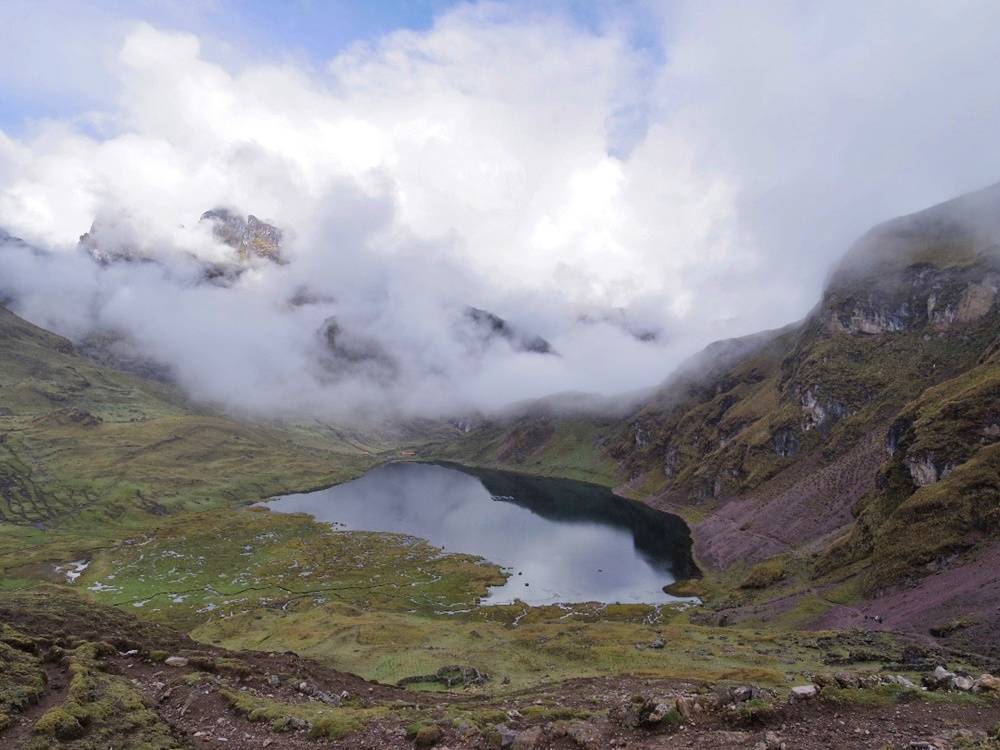
By Jenny of Girls Who Travel
The Inca trail is iconic, and it is on the bucket list of many hikers. With that comes a problem that lots of popular destinations face: overcrowding. 500 people hike the 4-day Inca Trail every day, which means there are 2000 people on the trail at any given time.
Those who look for an alternative should consider the Lares Trek. It’s a three-day hike which is considered moderate, though the altitude adds an extra challenge to those who aren’t used to it. It does, however, not just guarantee a peaceful, off-the-beaten-path trek, but also an authentic Peru experience.
You can do this trek solo, but if you do not have previous experience hiking at altitude, take a guide. Alpaca Expeditions offers great services and comes highly recommended by many. This includes a guide, porters, and a chef.
What can you expect? Your tour will start in Cusco. The drive to the starting point offers stunning views of the Sacred Valley and a stop at Lares Hot Springs.
The hike leads through stunning scenery in the mountains. The best part, however, is meeting the local people who live in these remote mountains.
Tour websites encourage people to bring school supplies to give out as gifts to the villagers. But there are other items that are much more needed and welcome. Ask your tour guide right at the start, and you will be able to stop at a local market and shop.
The Maras Salt Mine is a highlight on day 3, which ends with a train ride from Ollantaytambo to Aguas Calientes, from where you will visit Machu Picchu on your last day.
Hiking the Lares Trek is an unforgettable experience.
Ollantaytambo

By Cynthia of Sharing the Wander
Ollantaytambo is a small town in the Sacred Valley that is well known mostly because this is where you catch the train to Machu Picchu. However, there’s a lot to love about this town!
Called “The Last City of the Incas”, the city was once an Incan trading post, located at the base of three valleys – where the people of the valleys, the jungle, and the coast could meet. All around the town, beautiful mountains rise up, creating spectacular views.
You’ll find a central square with cafes all around, and back alleys full of buildings built with large Inca stones where water rushes past and farmers lead cows to their next pasture.
The Ruins of Ollantaytambo at the far side of town involve climbing a lot of stairs. At the top, you’ll find the remains of the Sun Palace. This was once an astronomical observatory and then became a fortress when the Spanish attacked. Most of the palace was dismantled in the subsequent search for gold and other treasures.
On the other side of the hill, you’ll find the Ruins of Pinkuylluna, which are free to climb and explore. Once used for food storage, from these structures you have great views across to the ruins of Ollantaytambo.
Ollantaytambo is a great family destination, kids have plenty of room to run and explore on the car-free streets. Don’t miss the lucuma ice cream– a fruit flavor native to Peru that tastes a bit like butterscotch.
It also makes a great base for exploring the rest of the Sacred Valley. You can easily take day trips from Ollantaytambo to Moray, Maras, Urubamba, and more. When you are ready to move on, take the train to Aguas Calientes to start your Machu Picchu adventure.
Located a 1 ½ hour drive from Cusco, Ollantaytambo has a significantly lower altitude. After landing in Cusco, head directly to Ollantaytambo to acclimate and avoid altitude sickness before exploring higher elevations.
Cusco
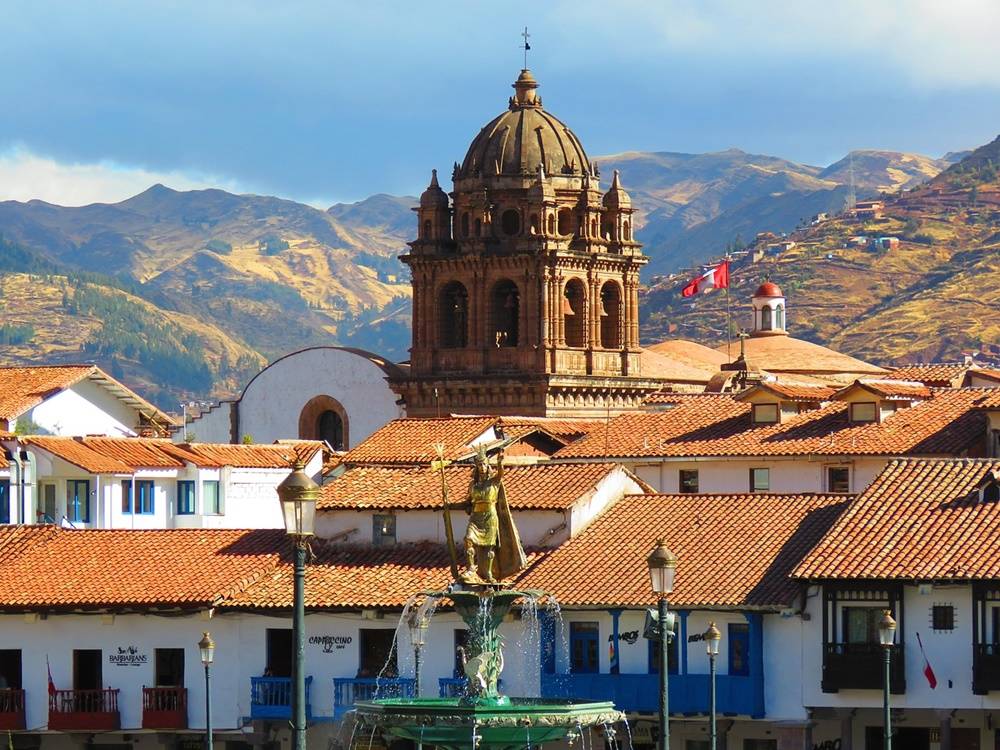
By Shweta of Zest in a Tote
If you are visiting Peru, chances are high that you are visiting Cusco as well, the former capital of the Incan empire. Cusco is the starting point for a day tour to Machu Picchu, the Incan trail, and the panoramic Salkantay Trek that we visited as part of our Peruvian adventure.
Cusco offers accommodation options for every budget, from hostels to Airbnbs to hotels. Cusco is a walkable city and you are never too far away from the center.
If you are coming from anywhere close to sea level, you need to acclimate to the altitude in Cusco (at 3399 meters above sea level) and do nothing for a day. You can try drinking coca leaf tea to make you feel alright!
Besides being a gateway to Machu Picchu and the Rainbow Mountains, Cusco is a destination in its own right.
A UNESCO World Heritage site, Plaza de Armes is the central square of the city where you can sit at one of the cafes and see the world go by.
You can marvel at the remains of Koricancha, considered one of the holiest sites in Incan mythology
Walk around in the bohemian San Blas street and enjoy its cafes, nighttime bars, and souvenir shops.
There are excellent chocolate houses in Cusco and you can sample the local products and buy some to take home. A cooking class that teaches you about the history of food in Peru is also an interesting thing to do.
Chachapoyas


By Jürgen of Dare2Go
The region around Chachapoyas in the north of Peru has so many attractions that it deserves a much longer post, especially since it is lesser known to international visitors. Its biggest disadvantage right now is that infrastructure is not as well developed as in the more famous Cusco region.
The town and region are named after the Chachapoya nation, who inhabited this part of Peru long before the Incas came to power and it was one of the last to submit to Inca power. For centuries the Chachapoya had their very own unique culture and rites and left many remarkable traces.
To be brief let’s make a list of places you should visit:
Kuélap Ruins: High in the mountains are the well-preserved ruins of Kuélap, which used to be a stronghold of the Chachapoya nation; part fortress, part city. Today around 470 of the unique round houses are partly preserved inside the 20-meter-high walls.
In 2017, a cable car made Kuélap more accessible. This site is sometimes marketed as the “Machu Picchu of the North” although, apart from its magical mountaintop location, there aren’t many similarities and Kuélap is hundreds of years older.
Karajia Sarcophagi: To the north-west of the Chachapoyas, you find the cliff tombs of Karajia. These are ancient burial places of highly respected people. The graves are high up under cliff overhangs in very unique sarcophagi, made from bamboo and dried clay, painted in white and red. Some shapes resemble tall priest-like figures, complete with expressive face masks.
Gocta Waterfall: On the way to Karajia, you can catch a glimpse of the Gocta Falls; some tours will include a hike to the falls in their packages. At 770 metres these are among the tallest waterfalls in the world.
Leymebamba Mummy Museum: The Centro Mallqui was purpose-built to house over 200 mummies and other artifacts found around the Laguna de los Cóndores. These mummies are stored in special climatized, darkened chambers with viewing windows. You might have to ask staff to turn the lights on for your visit.
Tip: if you plan to visit Chachapoyas by bus from the coast, get off to stay in Leymebamba, visit the museum the next day, and then continue by minibus. It will save you a long return trip!
Mausoleums of Revash: The Revash site is best visited in combination with the Centro Mallqui because they are along the same section of road. Here you find, dotted around steep rock faces, numerous old graves, which often resemble small houses, all decorated in dark red patterns.
The City of Chachapoyas, which also serves as the capital for the Amazonas Region, is very pleasant and clean, but has none of the busyness of Cusco. You can find accommodation from budget to upmarket and food choices to match.
If you want to get a good feel for the Cloud Forest and its sights you should plan for at least 4-5 days, as transport options to the outlaying sights are limited.
Getting to Chachapoyas is still not really easy. Nowadays the airport has been extended and there are 3 or 4 flights a week from Lima. Or you could fly into Jaén and take a bus from there.
The budget option by bus from Lima will be a tedious and possibly treacherous ride of around 22 hours or longer. The last hundred or so kilometers are along a winding single-lane bitumen road with sheer drops down the side.
Alternatively, you could take the day bus from Cajamarca, another beautiful colonial city with a rich history, well worth a visit. (Everybody recommends to avoid the night bus!)
Once you are in Chachapoyas, why not continue into La Selva, as the Peruvians call their bio-diverse Amazon lowlands? The Amazon tributaries in Peru cover a larger area than the more famous river section in Brazil.
Machu Picchu

Claudia of My Adventures Across The World
There is no doubt that Machu Picchu is the best place to visit in Peru. This 15th-century citadel is a must-see – especially if it is your first time in the country! A UNESCO World Heritage Site, Machu Picchu was built at the peak time of the Inca civilization.
Machu Picchu is located in the jungle of the Andes Mountains, at about 2,400 meters above sea level, above the Urubamba Valley. The site is stunning and quite widespread.
Look at the buildings carefully and you will immediately notice the difference between the most important buildings such as temples (actually built following specific astronomical alignment, for which the dry-stone technique was used) and the most modest ones where mortar was used instead.
Sights you should not miss include the Hut of the Caretaker of the Funerary Rock, from where you will have one of the best views of the site, the Central Plaza, the Sun Temple, the House of the High Priest, the Inca Drawbridge, the Temple of the Condor, and the Temple of the Three Windows.
For the most sweeping views of Machu Picchu, you can also hike to Wayna Picchu, but you will need a separate ticket for that and must pick a time slot.
To make the most of the site, you should join a guided tour. Machu Picchu is best explored on guided tours. The site is spread out and actually quite crowded so it can feel overwhelming.
The closest large city to Machu Picchu is Cuzco, but the nearest access town is actually Aguas Calientes, also known as Machu Picchu Pueblo, which is about 100 km (62 miles) from Cuzco and can be reached on a combination of bus and train from Cuzco. To get to Machu Picchu from Aguas Calientes you can hop on one of the many shuttle buses that ply the route from the early morning hours.
Another way of getting to Machu Picchu is to walk the Camino Inca or the Inca Trail. This is a 4-day hike that goes along the sacred route the Incas would follow to get to Machu Picchu. You will get to visit many other beautiful sites along the way, though to many the highlight of the Inca Trail is seeing the sunrise over Machu Picchu.
Iquitos
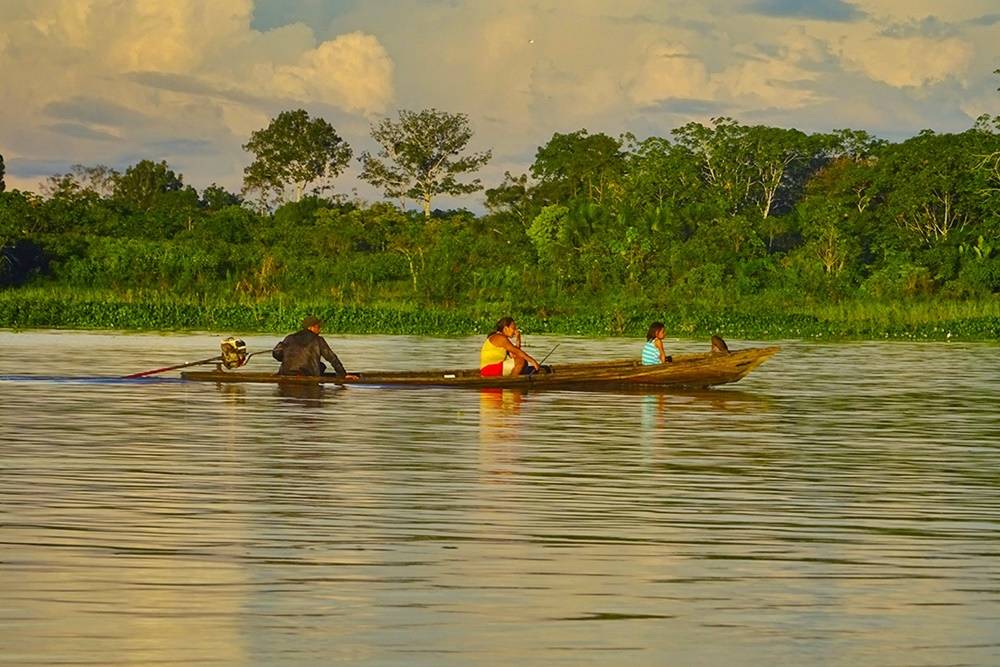
By Alex of Career Gappers
The remote, isolated city of Iquitos is one of the most unique places to visit in Peru, and a captivating alternative to northern Brazil if you want to experience the Amazon rainforest.
Iquitos is roughly a thousand kilometers north of Lima as the crow flies, and is surrounded by impassable jungle. This means you can only reach the city by plane (it’s a two-hour flight from Lima) or an adventurous boat journey that takes several days.
When you arrive in Iquitos, you will quickly see that it is completely different from other Peruvian cities in terms of its culture and atmosphere. Colorful adobe houses with handmade straw or clay-tiled roofing line the streets, which are constantly abuzz with tuk-tuks coming and going. Crumbling old colonial buildings encircle the city center plazas, intertwined with unpretentious cozy family restaurants.
The main appeal of visiting Iquitos is the opportunity to explore the Amazon River. You can take day trips or multi-day tours from the city and venture deep into the rainforest.
Typical tours will include overnight stays at a jungle lodge, a chance to encounter Amazonian wildlife in its natural habitat such as wild pink dolphins, howler monkeys, and bullet ants, and meet indigenous communities to learn about their way of life.
Back in the city, there’s plenty to do as well. The Ayapua Boat Museum on a century-old steamship gives an insight into Iquitos’ heritage and the once-thriving rubber trade. For an insight into local life, you could spend a morning at the huge, sprawling Belén Market on the riverside.
Finally, you could treat yourself to a meal at Al Frio y Al Fuego, a floating restaurant on the Itaya River where you can try local Amazonian dishes.
Colca Canyon
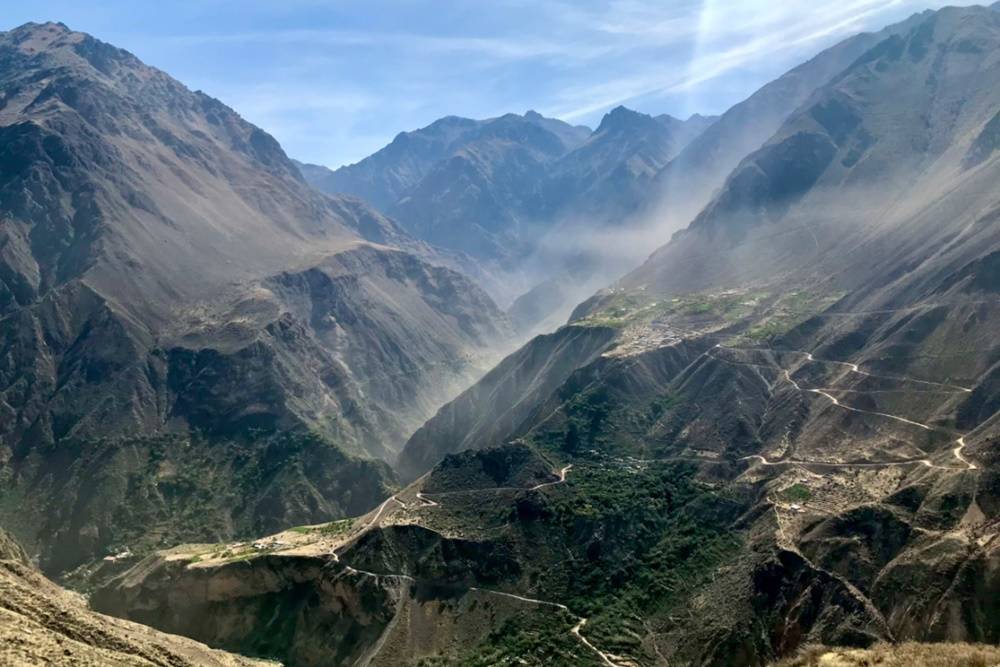
By Coni of Experiencing the Globe
Whether you’re in for a multiday backpacking trip or you just want to spend a relaxing day in nature, the Colca Canyon is the perfect getaway!
Overshadowed by Machu Picchu and the countless outdoor activities around Cusco, the Colca Canyon doesn’t receive the attention it deserves. But it absolutely should. It’s one of the deepest and biggest canyons in the world (it’s around 2000m/6600 ft deep, and 70 km/43 mi long), and the ever-changing landscapes will captivate you with every corner you turn, no matter in which season you visit.
Even with that said, keep in mind that December to April is the wet season, with most rain falling during this time, while the dry season lasts from May to November.
The easiest way to get there is from Arequipa (the Canyon is located 160km/100 mi northwest of the city). There are organized day trips that will allow you to scratch the surface: you can visit the village of Chivay, see the “Mirador de Cóndores” (a viewpoint to observe the imposing Andean vultures), and soak in natural hot springs.
If you want to go deeper into the canyon (literally!), allow yourself a few days for a multiday trekking trip in the Colca Canyon. Take a bus to Chivay or to Cabanaconde, and trek away.
There are several inhabited tiny villages on the way, and all of them offer accommodation and board (ranging from fancy-ish hotels to very humble and basic rooms). There are plenty of different routes, but a popular one goes from Cabanaconde to Llahuar to the oasis of Sangalle. If you want to extend the hike, you can add Fure and its beautiful waterfall, or the quiet San Juan de Chuccho.
Ayacucho
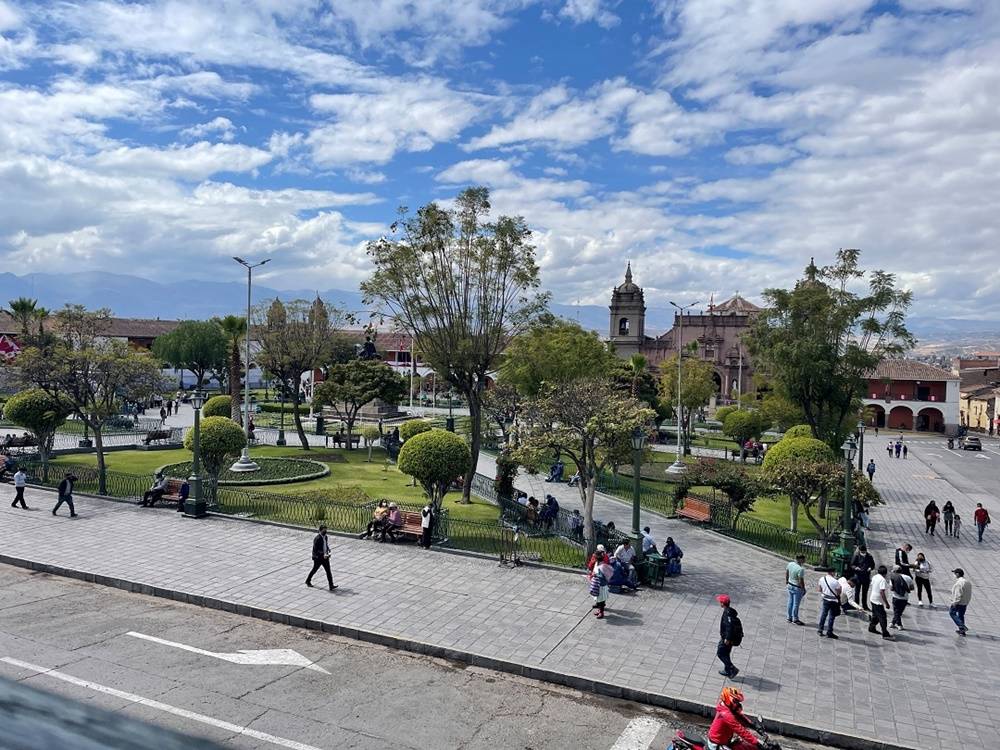
By Sharon of I Travel Peru
Ayacucho is a region in the Andes mountains of Peru, a mix of traditional Peruvian culture, archaeological sites, and nature. It offers an authentic Peruvian highlands experience while remaining relatively undiscovered by mainstream tourists, making it a unique destination to explore.
There are many things to do in Ayacucho, both in the city and in the surrounding areas. It’s a perfect location to spend some time if you like to travel slowly, and you can easily spend at least 4 days in the area doing different activities every day.
The city is a great place to walk around exploring the streets, colonial buildings, local markets, and churches.
But it’s especially the surrounding areas which make it such an interesting place to visit.
For example, you can visit Vilcashuaman, a small village in the middle of the mountains which has some impressive Inca ruins basically in the middle of the town. And you might possibly be the only tourist around! The village boasts fantastic mountain views, making it an obvious choice for the Incas to establish an important site there.
Another popular activity is a visit to the Wari ruins, a pre-Incan site that is still not completely explored by archaeologists where you will learn a lot about Peruvian history.
If you are looking to spend some time in nature, a popular spot is Millpu, a set of natural turquoise pools on the slope of a mountain.
To get to Ayacucho you can either go by plane or take a bus. From Lima, the flight is just 1 hour long, while going by bus takes around 10 hours.
Arequipa

By Michael of Time Travel Turtle
Peru’s second-largest city wears its colonial heritage as a badge of honor. Founded by the Spanish in 1540, its old town is full of architectural styles brought over from Europe – baroque, then rococo, neoclassicism, and modern empiricism. The density and quality of these monuments have led to the historic center being listed as a World Heritage Site.
There are lots of things to do in Arequipa, from the Plaza de Armas to the Basilica Cathedral, plus a range of museums and local markets. One of the highlights is the Monastery of Santa Catalina, where wealthy Spanish families sent their daughters for a life much more luxurious than you would expect for nuns.
Considering its size, Arequipa feels relatively quiet – more like Cusco than Lima. And with snow-capped mountains forming the backdrop, it can sometimes seem like an extension of the natural environment. It’s one of the reasons the city has a reputation for a laidback approach to life, with plenty of fun places to eat and drink.
Arequipa is well connected by public transport and easy to reach from other parts of Peru. While it’s certainly a destination in itself, it’s also an excellent base to explore the region on day (or overnight) trips. A couple of the nearby highlights are the Colca Canyon and Salinas y Aguada Blanca National Reserve.
Tambopata National Reserve
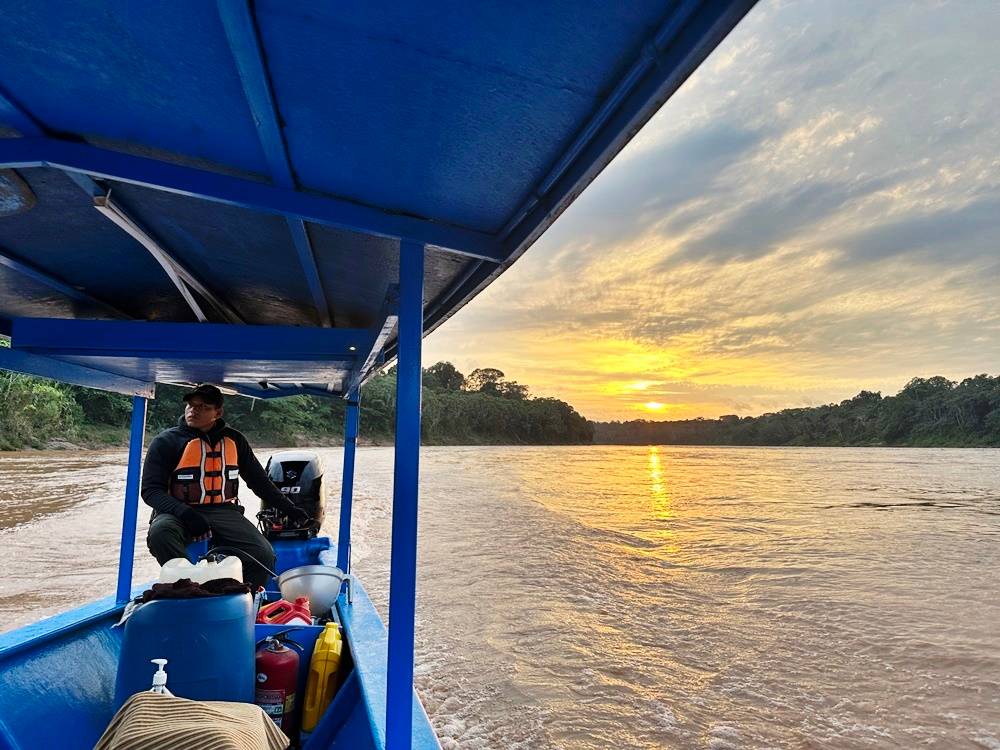
By Ariana of World of Travel With Kids
Tambopata National Reserve is one of the best places to experience the Amazon jungle in Peru; not only is it stunningly beautiful and well preserved, it is also easily accessible if you are combining an Amazon trip with Cusco and Machu Picchu.
The Tambopata Reserve centers on the Tambopata River area and includes a large protected area which means the jungle is highly biodiverse (eg, there are so many animals, birds, butterflies, and more!).
If you are investigating a trip to the Amazon jungle in Peru, there are several important considerations which include time and budget. In short, the longer you have (and the more money you spend) the deeper you can get into the remote jungle where you are likely to have incredible experiences.
That’s where Tambopata comes into its own; due to the very winding nature of the river, you can take a 2-hour road trip from Puerto Maldonado city (where the airport is located) and that’s the equivalent of 5 or 6 hours on the river (eg. You can get into the deep dark jungle quickly). Throw in the fact that Puerto Maldonado is a one-hour flight from Cusco – and you can wake up sipping coca tea in Cusco and eat your lunch on the river spotting capybaras and caimans. It’s awesome!
The best thing to do while in Tambopata is to look for an eco-conscious lodge that provides a wide range of activities designed for low-impact animal sightings and jungle exploration. From night walks to Citizen Science projects, canoes on oxbow lakes, or climbing canopy towers to watch sunsets or gaze at macaws heading home, there are loads of things you can see and do.
Top tips – there are no direct flights to and from Cusco each day; check the flight days so you can maximize your time in the jungle and avoid sitting in Lima airport. Also, pack long sleeves and natural insect repellent!
Rainbow Mountain
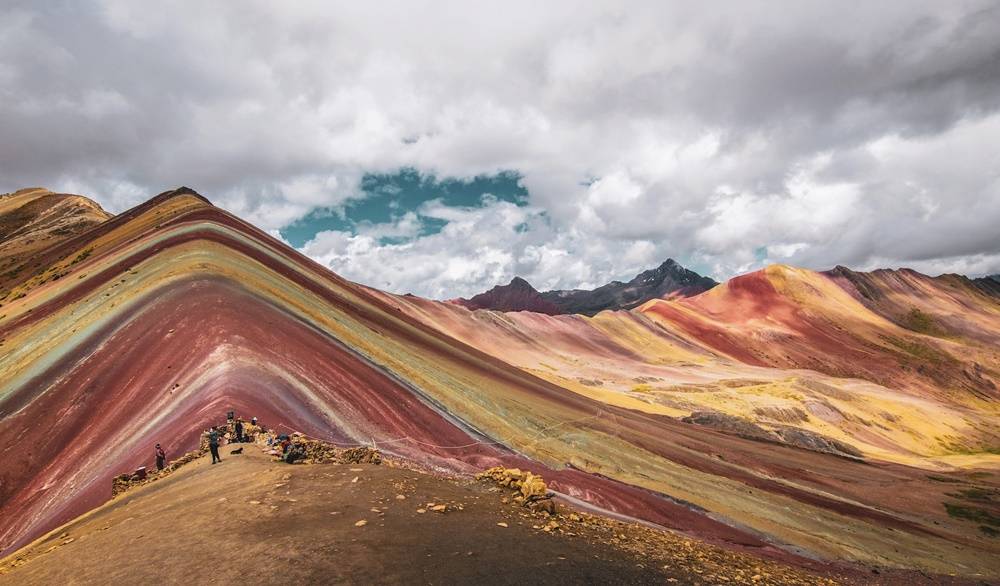
By Raksha of Solo Passport
Part of the Willkanuta region of Cusco in Peru, the Rainbow Mountain is the second most popular tourist destination after Machu Picchu. Formed due to the shift in tectonic plates, the Rainbow Mountain features seven distinct colors, making it very picturesque and photogenic. The different colors are due to the mineralogical composition of sand and mud and each mineral gets a different color.
Among the locals, the Montaña de los Siete Colores is considered sacred and the symbol of father and masculinity.
The best time to visit this mountain is between June and August when the weather is dry and pleasant.
Standing tall at an altitude of 5200 meters, this mountain is best known for its high-altitude hike. To reach the summit, you need to hike. As this is one of the tough hikes, you need to be reasonably fit to climb the mountain.
Starting from the village of Fula Wasi, which is around 140 kilometers from Cusco, the trail passes through rugged paths and is around 5 kilometers one way.
You can reach the nearby village of Checacupe by public bus from Cusco and then hire a local taxi to reach Fula Wasi.
There are many hiking agencies and one-day tours that go to the Rainbow Mountain from Cusco. Most of these agencies have transportation to and from included in their price. This is the best option when you are short on time and do not have a self-driven car.
Lake Titicaca Islands

By Martha of May Cause Wanderlust
Lake Titicaca is a spectacle of natural beauty. It’s the highest navigable lake in the world and the largest lake in South America – and is shared between Peru and Bolivia. This huge lake is overlooked by snow-capped mountains and its surface is punctuated by captivating islands.
Visiting one or more of the Lake Titicaca islands, each having its own unique culture, is a fascinating thing to do. They’re unlike anywhere else and they make Lake Titicaca one of the most unique places to visit in Peru.
There are three populated islands on the Peruvian side of the lake.
The easiest to visit is actually a collection of many islands – and, mind-blowingly, they’re man-made! The Uros Floating Islands are home to the Uros people, who made their homes on the lake by weaving together thick layers of totora reeds that form floating platforms.
Boat tours are able to land at certain islands, where the people will demonstrate a little of their way of life, and you can see their traditional houses and boats, also made from reeds.
Another island you can take day tours to is Isla Taquile, which is further out into the lake – and offers stunning views across the water. Isla Taquile retains its very traditional way of life and is known for its unique textiles and traditional dress.
It is a car-free island and has a collectivist economy, based on fishing, horticulture, and tourism, from which all islanders benefit.
Finally, Isla Amantani is the largest and most populated island, and most visitors visit with a homestay. This island is known for its textiles, ceramics, and archaeological ruins from the Tiahuanaco culture.
All three islands on Peru’s part of Lake Titicaca are reachable from the city of Puno, which is connected by buses and the airport at nearby Juliaca.
Huacachina

By Jack & Abbie of A Couples Calling
Huacachina is undoubtedly one of the most unique places to visit in Peru. Famous for its towering sand dunes, exhilarating activities, and bustling nightlife, this charming desert oasis has something for everyone!
With plenty of restaurants, bars, and markets here, Huacachina is a great place to just relax. However, it’s also the perfect destination for adventure lovers, as there are tons of awesome activities on offer.
First of all, you’ll want to explore these massive sand dunes by dune buggy. This activity is really popular, but you can still simply rock up and book it on the day! Better yet, you can do a combination bundle that includes sand boarding too.
If you’re after something a bit more leisurely, then why not rent a paddleboat to explore the oasis or enjoy a drink at one of Huacachinas’ rooftop bars?
A real highlight is walking to the top of the dunes, where you’ll get to admire an epic sunset. However, the hike to the top is pretty intense, so you can always park yourself a bit further down and enjoy the view instead.
Although there are plenty of things to do in Huacachina, you won’t need more than a day or two here. In fact, you can visit on a day trip from Paracas or even Lima (although the latter will require a 10-hour tour).
For those staying in Paracas, it’s just a 1-1.5 hour bus ride to Ica. From Ica, you can take a cheap tuk-tuk ride to Huacachina which takes around 10 minutes so it’s easily accessible.
This desert oasis is one of the country’s most unique destinations and has so much to offer considering it’s just a small place.
Maras Salt Mines
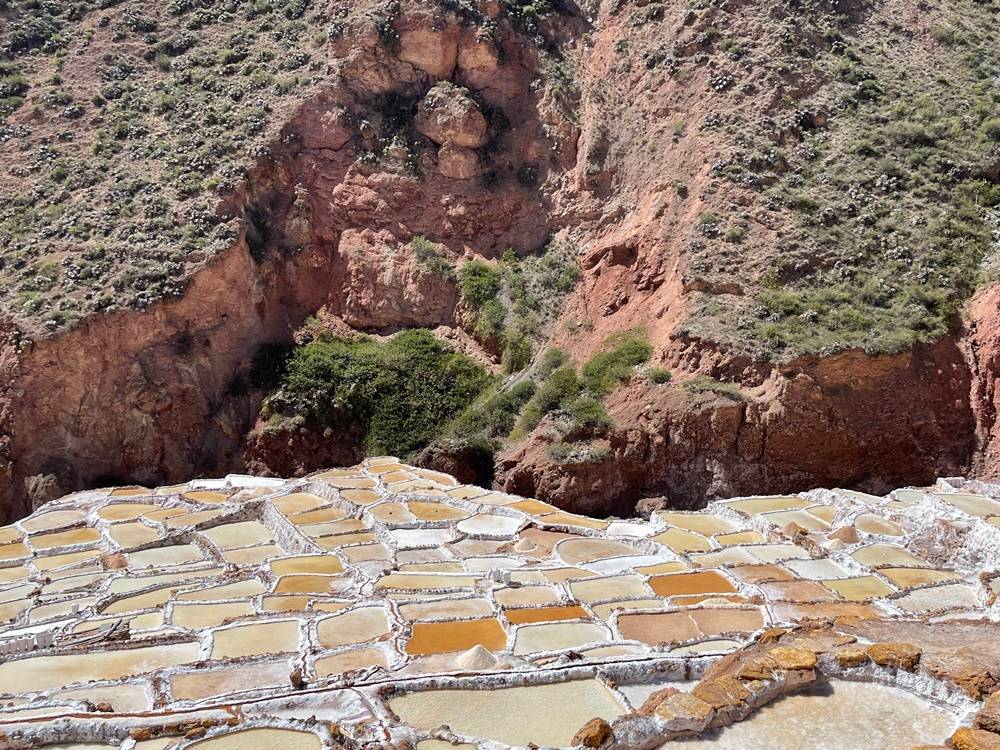
By Jennifer of Seeking Stamps
If you are looking for one of the most unique destinations in Peru, consider exploring the Salt Mines of Maras in the heart of the Sacred Valley. With thousands of vibrant salt pools predating the Inca civilization, Maras is a fascinating day trip from Cusco.
For over 500 years, villagers have used traditional techniques to harvest precious Peruvian salt at the Maras Salt Mines.
Fed by salty mountain springs and complex irrigation, locals flood their salt pools. Over time, the water evaporates from the elements in the Andean climate. Then villagers gather the remaining salt crust and repeat the labor-intensive process for their harvest.
Watching locals work in their salt pools will give you a new appreciation for the labor required to harvest Peruvian salt.
As a visitor to the salt pools, you will enjoy awe-inspiring views. Terraced salt pools range in ombre shades of orange to beige as far as the eye can see. Additionally, the journey to Maras offers stunning mountainscapes of the Andes. This picturesque location is truly unique.
Approximately 30 miles from Cusco, there are several ways to reach the Maras Salt Mines. Although the location of Maras is remote, there are a variety of tour options that combine Maras and Moray Ruins in a Sacred Valley tour. For adventure lovers, consider hiking to Maras or taking an ATV tour to the site.
As you can see, the Maras Salt Pools are one of the best day trips to take in Peru’s Sacred Valley. With beautiful scenery, rich cultural heritage, and fascinating sustainable harvesting techniques, Maras offers a multitude of reasons to visit. Consider Maras, Peru for a thrilling Cusco excursion.
Paracas

By Tori of Tori Pines Travels
While exploring the country of Peru, Paracas needs to be high on the list. The small coastal town is located just 3.5 hours south of Lima. It makes for a perfect stop on a trip from Lima to Huacachina.
The town itself is cute and fun to visit, the streets lined with palm trees, friendly locals to meet, and delicious authentic Peruvian cuisine is served at the local restaurants. But the main reason to visit Paracas is for the boat tour out to the Ballestas Islands.
The islands are home to some adorable wildlife including penguins, sea lions, seals, and Guanays. You’ll want to book a boat tour that leaves from the little port in the small town of Paracas. Or take a day trip through Peru Hop which leaves from Lima and includes both Paracas and Huacachina.
While you’re on the boat, you’ll pass some of the Nazca lines on your way to the islands. At the islands, you’ll see tons of animals living in their natural environment from a safe distance. The penguins are especially cool to see, as you don’t even have to visit Antarctica to see these adorable birds!
Along the way, your tour guide will teach you some amazing information about the animals, the islands, and the history of the area. Even explain to you the history of the Chifa cuisine, which you’ll see restaurants for all over the country.
Not only is it fun to see the animals, and learn the history, you’ll also get a super relaxing 2-hour boat ride. It’s quite the difference from all of the famous sights inland. Cap off your beach time by staying the night at a hotel right on the water, at Inti-Mar, and spend some time with your toes in the sand.
Laguna 69, Huaraz
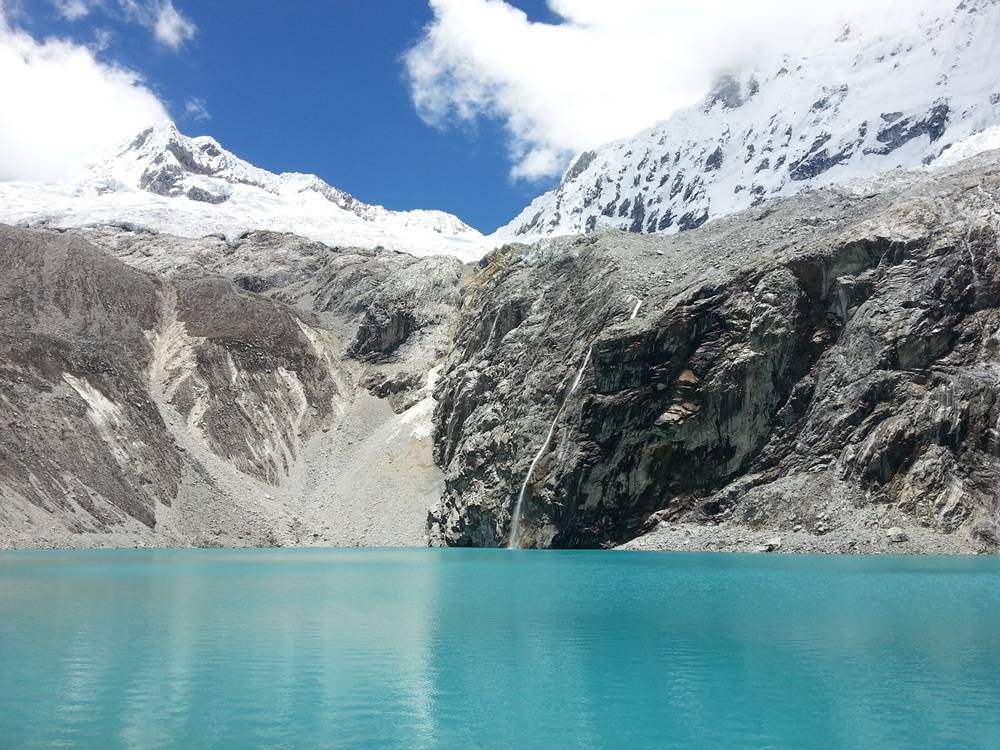
By Claire of Tales of a Backpacker
Laguna 69 is a beautiful turquoise-blue lake high in the Sierra Nevada mountain range. It can only be reached on foot, so a day hike to Laguna 69 is a popular tour from Huaraz.
It is possible to hike to Laguna 69 without a guide, but there is hardly any public transport here so it is much easier to join a group tour from Huaraz, which costs around $45 USD per person. Leaving early from Huaraz (around 5 AM), there is a 3-hour drive to reach the start of the trail to Laguna 69.
It is a challenging hike mainly due to the elevation, which starts at 3900m above sea level at the trailhead and reaches a breathtaking 4600m. Make sure you are fully acclimatized to high altitudes before attempting the hike, otherwise, you probably won’t be able to make it to the lake.
As you hike you’ll be surrounded by stunning scenery and views of the Cordillera Blanca Mountains. Those who do reach Laguna 69 are rewarded with the turquoise glacial waters of the lake and a cold swim if you fancy a dip!
The whole hike takes around 5-6 hours, and if you set a decent pace you’ll have plenty of time to enjoy the view before heading back along the same trail.
On the way, you pass through the UNESCO World Heritage-listed Huascaran National Park, where you may spot some vicuña, a rarer relative of the llama. On the return bus journey just sit back and relax, and catch up on some sleep – you’ll need it!
Ausangate Trek
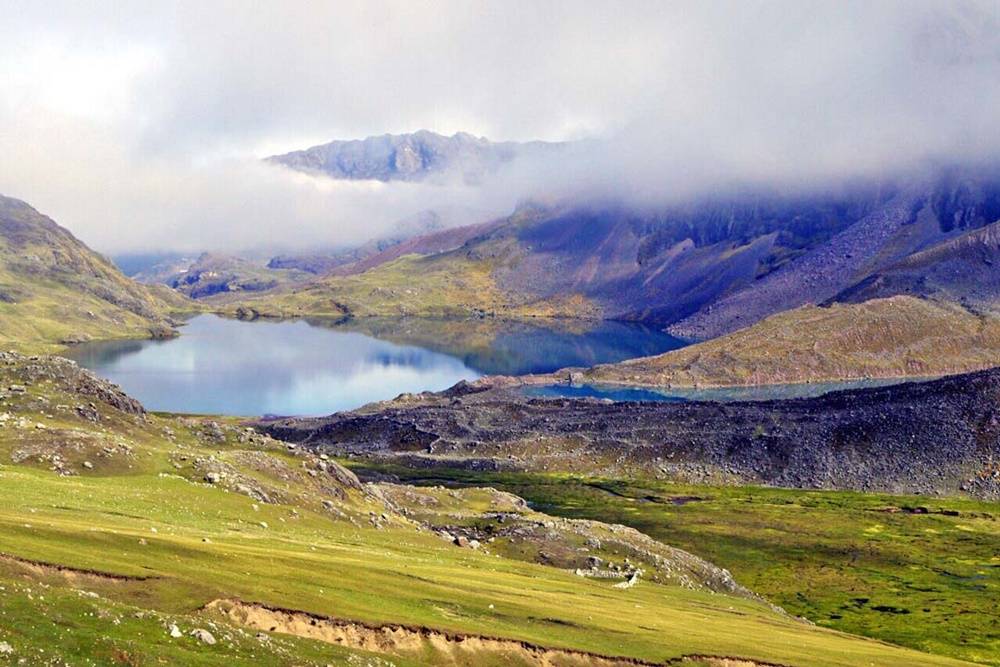
By Campbell of Stingy Nomads
The Ausangate Trek is a 70km long, high-altitude trek through the Vilcanota Mountain Range near Cusco in Peru. It takes on average 6 days to complete the route.
This spectacular trail shows off some of the best scenery Peru has to offer with jaw-dropping snow peaks, glaciers, and colorful mountain lakes. This challenging hike with an average altitude of over 4000m is truly off the beaten track.
You should be well prepared if you want to do this trek without a guide. Hiking independently should only be attempted by well-acclimatized and experienced hikers. Some companies offer guided hikes from Cusco if you don’t want to do it on your own.
Ausangate is not about Inca ruins, it’s all about amazing scenery. The trail starts and ends in the small village of Tinque where you might see locals still wearing traditional Quechua clothes. You will hike over beautiful mountain passes such as Arapa Pass at an altitude of 4850m/16 000ft and Palomani Pass at 5165m/17 000ft above sea level, and see amazing turquoise, glacial lakes like Puca Cocha and Japu Cocha lake.
On route, you will camp overlooking unreal glaciers and see glacial lakes of different colors and mountains ranging in coloration from shades of red, pink, yellow, green, and blue. Many amazing animals such as alpacas, llamas, vicuñas, and vizcachas are often seen on the trail.
The most well-known attraction on the trail is the Rainbow Mountain also known as Vinicunca. This unreal, rainbow-striped mountain can also be visited as a day trip from Cusco.
Lima
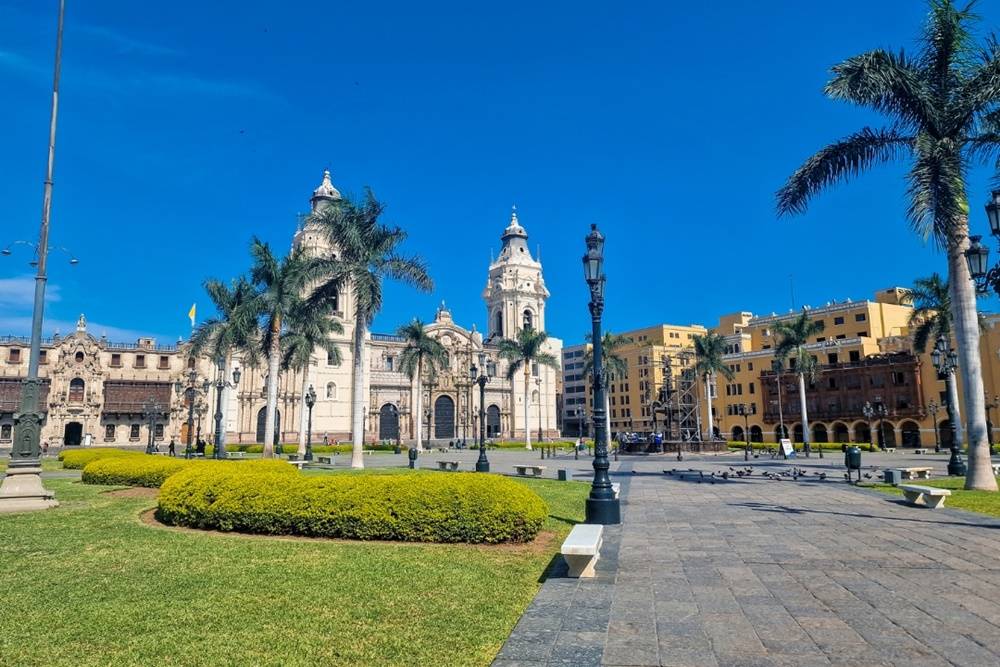
By Pauline from Beeloved City
No trip to Peru would be complete without visiting the famous capital city, Lima. Located on the coast, Lima is known for its food scene, UNESCO-listed historic center, beaches, and colorful neighborhoods.
There are so many things you can add to your Lima itinerary.
Firstly, head to the historic center. It’s where you’ll find famous buildings such as the government building, Plaza Mayor, Lima Cathedral, and San Francisco Convent. It’s a great place to learn more about the history of Peru (before and after the Spanish conquest).
For food, head to the Mercado Central. Spanning over 10 blocks, it’s an excellent place to have lunch and discover traditional Peruvian dishes.
It’s also located near Chinatown, the perfect place to discover how diverse Peru really is.
The best way to explore the historic center is with a walking tour. While it is beautiful, it can be a bit chaotic and being with a local guide is a huge plus.
If you’d rather enjoy the seaside and discover unique neighborhoods, Miraflores and Barranco will be perfect for you.
Miraflores is known as the best place to stay in Lima for first-timers. It’s full of shops, and restaurants and home to the Malecon (promenade) where you can find the Love Park and the statue of Paddington Bear.
Barranco is an artsy district. It’s a great place to discover if you are into street art and like going to cute cafes.
If you’re up for more adventures, you should also consider paragliding over the Costa Verde. It’s a lot of fun and you will discover beautiful views of the city.
Save it Pinterest for later:







